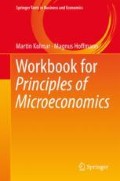Abstract
Assume a profit-maximizing firm.
-
1.
Assume that the firm supplies a strictly positive and finite quantity. Then, the rule “marginal revenues = marginal costs” holds in the optimum.
-
2.
A firm in perfect competition always supplies according the rule “price = marginal costs” if the resulting revenues at least cover the average variable costs.
-
3.
The firm will never make losses in its optimum because it can avoid these by leaving the market.
-
4.
In the long-run market equilibrium with free market entry and exit, a firm’s producer surplus is always equal to zero.
Assume a profit-maximizing firm with a cost function of \(C(y)=y^{2}+49\) in a market with perfect competition.
-
1.
The average costs of this firm are equal to the marginal costs at the minimum of the average cost curve.
-
2.
The average variable costs are \(AVC(y)=2y+\frac{49}{y}\).
-
3.
Assume that the firm only produces with one factor (labor), l. The wages are w = 4. That means that the production function of the firm is \(y=4\cdot l^{\frac{1}{2}}\).
-
4.
In the long-run market equilibrium with perfect competition and with free market entry and exit, the equilibrium price is p = 14.
Notes
- 1.
The graph alone gives no indication whether these fixed costs are technological (see Definition 8.6) or contractual fixed costs (see Definition 8.7). For this reason, we only know that FC > 0 if y > 0.
- 2.
The attentive reader will have noticed that there are two different terms whose square exactly corresponds to 2 l − 100. However, because we are looking only at positive outputs, the negative term \(-\sqrt{2\,l-100}\) can be omitted.
Author information
Authors and Affiliations
Rights and permissions
Copyright information
© 2018 Springer International Publishing AG
About this chapter
Cite this chapter
Kolmar, M., Hoffmann, M. (2018). A Second Look at Firm Behavior Under Perfect Competition. In: Workbook for Principles of Microeconomics . Springer Texts in Business and Economics. Springer, Cham. https://doi.org/10.1007/978-3-319-62662-8_9
Download citation
DOI: https://doi.org/10.1007/978-3-319-62662-8_9
Published:
Publisher Name: Springer, Cham
Print ISBN: 978-3-319-62661-1
Online ISBN: 978-3-319-62662-8
eBook Packages: Economics and FinanceEconomics and Finance (R0)

